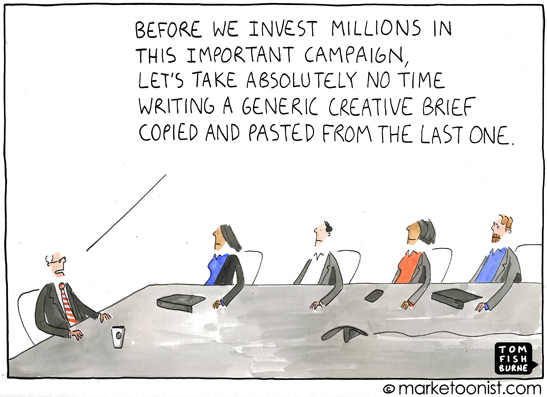The beginning of a creative project is an exciting time. But it can be daunting too, especially if you’re not exactly sure what you’re looking for. Writing a creative brief is an exercise in definition. It’s your chance to explore every aspect of your project, from audience to tone, core message to takeaway. Writing a good brief is also critical to the success of your project. To get things done right (without too many rounds of reviews), you need to make sure your brief communicates exactly what you want. While crafting a well-thought out brief might seem like a pain, it can actually be fun. No joke!

By taking the time to write everything out, you force yourself to really think through your campaign. Not only is it the most important thing you can do to ensure you get awesome content, every time, it’s also the most important thing you can do to make sure you’re connecting with your audience.
What is a creative brief anyway?
A creative brief is a roadmap for your project. It tells your team about your vision for the project and your goals, describes the people you want the project to reach (your audience), and outlines your brand guidelines. Depending on the type of creative team you’re working with – an in-house team, agency, or independent freelancers – the brief might also include details about deliverables, like how many drafts you expect from each team member, and when each draft will be due.
Why do you need a creative brief?
Writing a creative brief is as much about the process as it is about the end result. Writing a brief forces you to think your project through, from concept to delivery. This process can illuminate problems early, allowing you to make changes before you’ve paid for work, or put time into feedback. And chances are that if ideas don’t resonate when you present your brief internally, they’re not going to resonate when they get in front of your audience. When it comes time to execute, it’s the detail in a creative brief that really helps the team deliver. The clearer you are with your creative team, the better they’ll understand you and your brand, and the better able they’ll be to capture your message and overall vision on the first try. If your team looks like this when you’re done with your brief, chances are there’s more you could be doing:

A brief example
Here’s a common scenario: You have a great idea for a project, but as you start to write your creative brief, you realize your audience and campaign goals aren’t exactly in line with your metrics. You’re heading in the wrong direction and you need to switch formats and concepts to create something effective. To make the example more concrete: imagine you’re about to launch an infographic aimed at Millennials who like baking. You’re thinking it will be fun to include some humorous copy, a few recipes, and irreverent, kitschy visuals. But then you run some numbers and realize your Millennial audience isn’t spending a lot of time on your website – instead they’re mostly engaging with your brand on Facebook.

OK, quick pivot: you need short, engaging visuals you can share on social media channels. Suddenly snackable micro-content makes more sense. Maybe you want to do a series of Betty Crocker-inspired recipe cards instead of one big visual.
Your project just got a lot more engaging, a lot more shareable, and a lot cheaper! Why? Because you took the time to really think through your creative brief. You also saved a lot of time and effort. Rather than send your creative team down the wrong road with a wayward brief, you pinpointed exactly what you wanted before kickoff. Comprehensive briefs focus the creative process. They make it easier, more efficient, and more effective. And they vastly improve your chances of getting great results.
It’s time to write your creative brief, where do you start?
Once you have a solid concept and you know what type of deliverable you’re looking for you’re ready to write your brief. Remember to be as clear as you can about your vision. If you have ideas for icons or characters, transitions or colors, share them. You can always workshop your ideas with your team after you launch the project – the ideas don’t have to be set in stone – but sharing them now will give your team an informed place to start.
What to include in your creative brief: A checklist
- A paragraph or two about your project’s objectives
- Your core message and 3-5 proof points or benefits to your audience
- Notes on themes or ideas, you want the creative to embrace. Make sure to be clear about how closely (or loosely) you want them followed.
- Your audience: Describe them briefly, give key demographic information, and provide any insights you have about what they’re trying to achieve (and how you’ll help them achieve it).
- The primary call-to-action or takeaway message.
- Some examples of what success would look like (website traffic, sales, etc.)
- Examples of projects you like (or that have been successful) in a similar format (videos, infographics, etc.)
- Brand and copy style guidelines: the fonts, tone, colors, logos, and other elements that will keep this content consistent with your brand. This doesn’t need to be in your creative brief necessarily, but you should at least explain how external teams can access your style guides.
- The specifications for the final product: file types, sizes, formats, etc.
- The full list of assets you need. Will you need a banner ad, too? A blog post? Copy for social media promotions? Scope creep is an easy way to get your project derailed and behind schedule.
- Clear information about both launch dates and due dates for drafts. (If you have flexibility, make sure to let your team know. Your team may have ideas they won’t share if they think there’s no time.)
Got all that? While you want to communicate all this information, you should also be able to distill it to a page or two (excluding style rules). If your creative brief comes off looking like a Tolstoy novel, chances are it’s not going to get read – or at the very least that some important details will be missed.
You have to really know what you want.
Putting in the time to pin down your project goals early in the process will save everyone time later. It will reduce the number of drafts your team needs to get it right, and will help to keep your project on time and on budget. You’ll get awesome content AND your creative team will be stoked to work with you. That’s at least four wins, not counting the love you’ll get when your campaign crushes it. So go forth, prosper, and don’t forget to brief!







